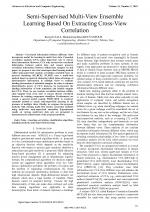| 2/2016 - 15 | View TOC | « Previous Article | Next Article » |
Semi-Supervised Multi-View Ensemble Learning Based On Extracting Cross-View CorrelationZALL, R. |
| Extra paper information in |
| Click to see author's profile in |
| Download PDF |
Author keywords
boosting, correlation, classification algorithm, sampling methods, semi-supervised learning
References keywords
semi(17), supervised(16), learning(15), data(15), recognition(11), multi(10), analysis(10), view(9), pattern(9), training(7)
Blue keywords are present in both the references section and the paper title.
About this article
Date of Publication: 2016-05-31
Volume 16, Issue 2, Year 2016, On page(s): 111 - 124
ISSN: 1582-7445, e-ISSN: 1844-7600
Digital Object Identifier: 10.4316/AECE.2016.02015
Web of Science Accession Number: 000376996100015
SCOPUS ID: 84974853415
Abstract
Correlated information between different views incorporate useful for learning in multi view data. Canonical correlation analysis (CCA) plays important role to extract these information. However, CCA only extracts the correlated information between paired data and cannot preserve correlated information between within-class samples. In this paper, we propose a two-view semi-supervised learning method called semi-supervised random correlation ensemble base on spectral clustering (SS_RCE). SS_RCE uses a multi-view method based on spectral clustering which takes advantage of discriminative information in multiple views to estimate labeling information of unlabeled samples. In order to enhance discriminative power of CCA features, we incorporate the labeling information of both unlabeled and labeled samples into CCA. Then, we use random correlation between within-class samples from cross view to extract diverse correlated features for training component classifiers. Furthermore, we extend a general model namely SSMV_RCE to construct ensemble method to tackle semi-supervised learning in the presence of multiple views. Finally, we compare the proposed methods with existing multi-view feature extraction methods using multi-view semi-supervised ensembles. Experimental results on various multi-view data sets are presented to demonstrate the effectiveness of the proposed methods. |
| References | | | Cited By |
Web of Science® Times Cited: 4 [View]
View record in Web of Science® [View]
View Related Records® [View]
Updated 2 weeks, 5 days ago
SCOPUS® Times Cited: 4
View record in SCOPUS® [Free preview]
View citations in SCOPUS® [Free preview]
[1] Multiview Clustering via Unified and View-Specific Embeddings Learning, Yin, Qiyue, Wu, Shu, Wang, Liang, IEEE Transactions on Neural Networks and Learning Systems, ISSN 2162-237X, Issue 11, Volume 29, 2018.
Digital Object Identifier: 10.1109/TNNLS.2017.2786743 [CrossRef]
[2] Transfer-based adaptive tree for multimodal sentiment analysis based on user latent aspects, Rahmani, Sana, Hosseini, Saeid, Zall, Raziyeh, Kangavari, M. Reza, Kamran, Sara, Hua, Wen, Knowledge-Based Systems, ISSN 0950-7051, Issue , 2023.
Digital Object Identifier: 10.1016/j.knosys.2022.110219 [CrossRef]
[3] A human fall detection framework based on multi-camera fusion, Ezatzadeh, Shabnam, Keyvanpour, Mohammad Reza, Shojaedini, Seyed Vahab, Journal of Experimental & Theoretical Artificial Intelligence, ISSN 0952-813X, Issue 6, Volume 34, 2022.
Digital Object Identifier: 10.1080/0952813X.2021.1938696 [CrossRef]
Disclaimer: All information displayed above was retrieved by using remote connections to respective databases. For the best user experience, we update all data by using background processes, and use caches in order to reduce the load on the servers we retrieve the information from. As we have no control on the availability of the database servers and sometimes the Internet connectivity may be affected, we do not guarantee the information is correct or complete. For the most accurate data, please always consult the database sites directly. Some external links require authentication or an institutional subscription.
Web of Science® is a registered trademark of Clarivate Analytics, Scopus® is a registered trademark of Elsevier B.V., other product names, company names, brand names, trademarks and logos are the property of their respective owners.
Faculty of Electrical Engineering and Computer Science
Stefan cel Mare University of Suceava, Romania
All rights reserved: Advances in Electrical and Computer Engineering is a registered trademark of the Stefan cel Mare University of Suceava. No part of this publication may be reproduced, stored in a retrieval system, photocopied, recorded or archived, without the written permission from the Editor. When authors submit their papers for publication, they agree that the copyright for their article be transferred to the Faculty of Electrical Engineering and Computer Science, Stefan cel Mare University of Suceava, Romania, if and only if the articles are accepted for publication. The copyright covers the exclusive rights to reproduce and distribute the article, including reprints and translations.
Permission for other use: The copyright owner's consent does not extend to copying for general distribution, for promotion, for creating new works, or for resale. Specific written permission must be obtained from the Editor for such copying. Direct linking to files hosted on this website is strictly prohibited.
Disclaimer: Whilst every effort is made by the publishers and editorial board to see that no inaccurate or misleading data, opinions or statements appear in this journal, they wish to make it clear that all information and opinions formulated in the articles, as well as linguistic accuracy, are the sole responsibility of the author.



